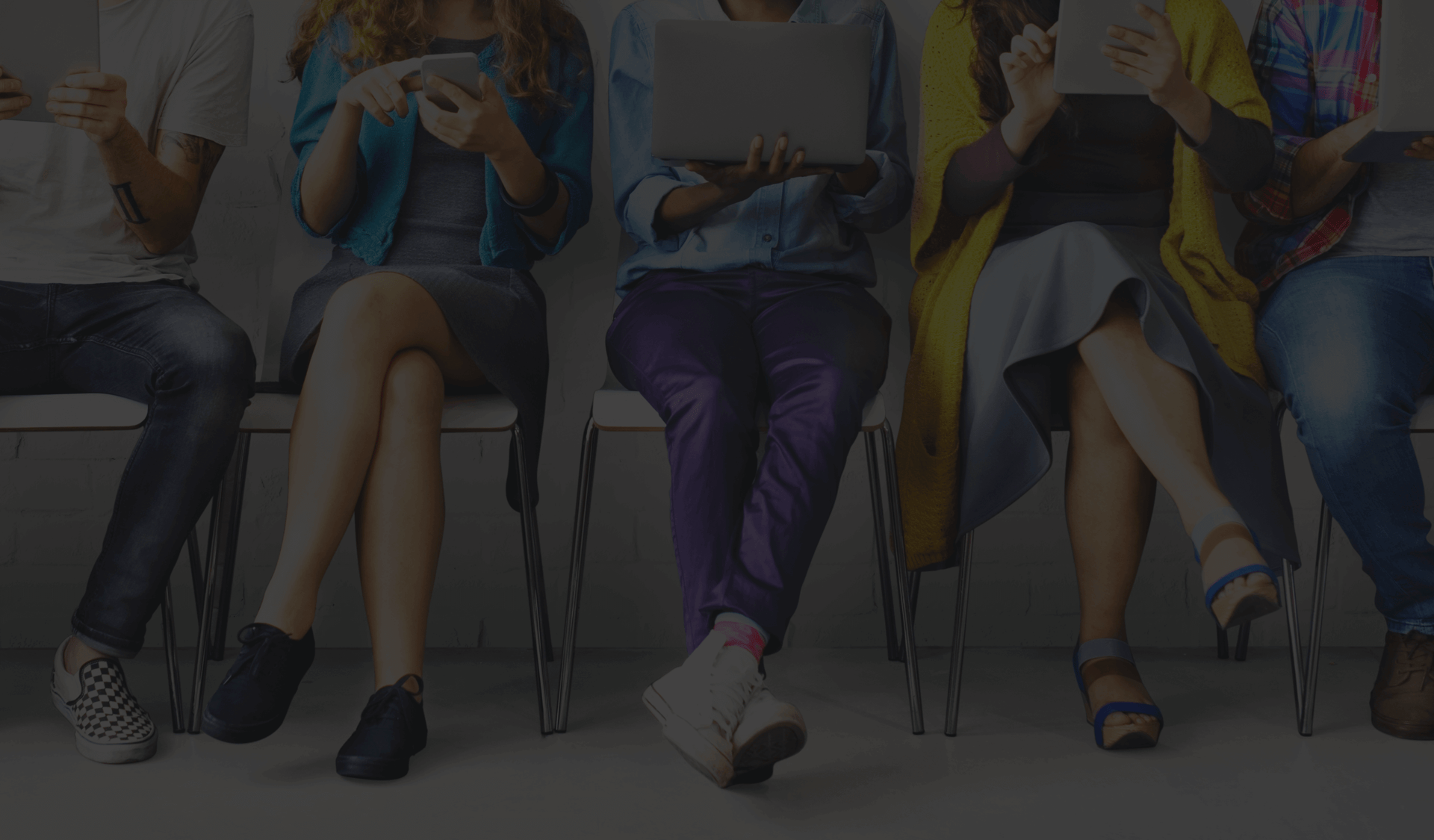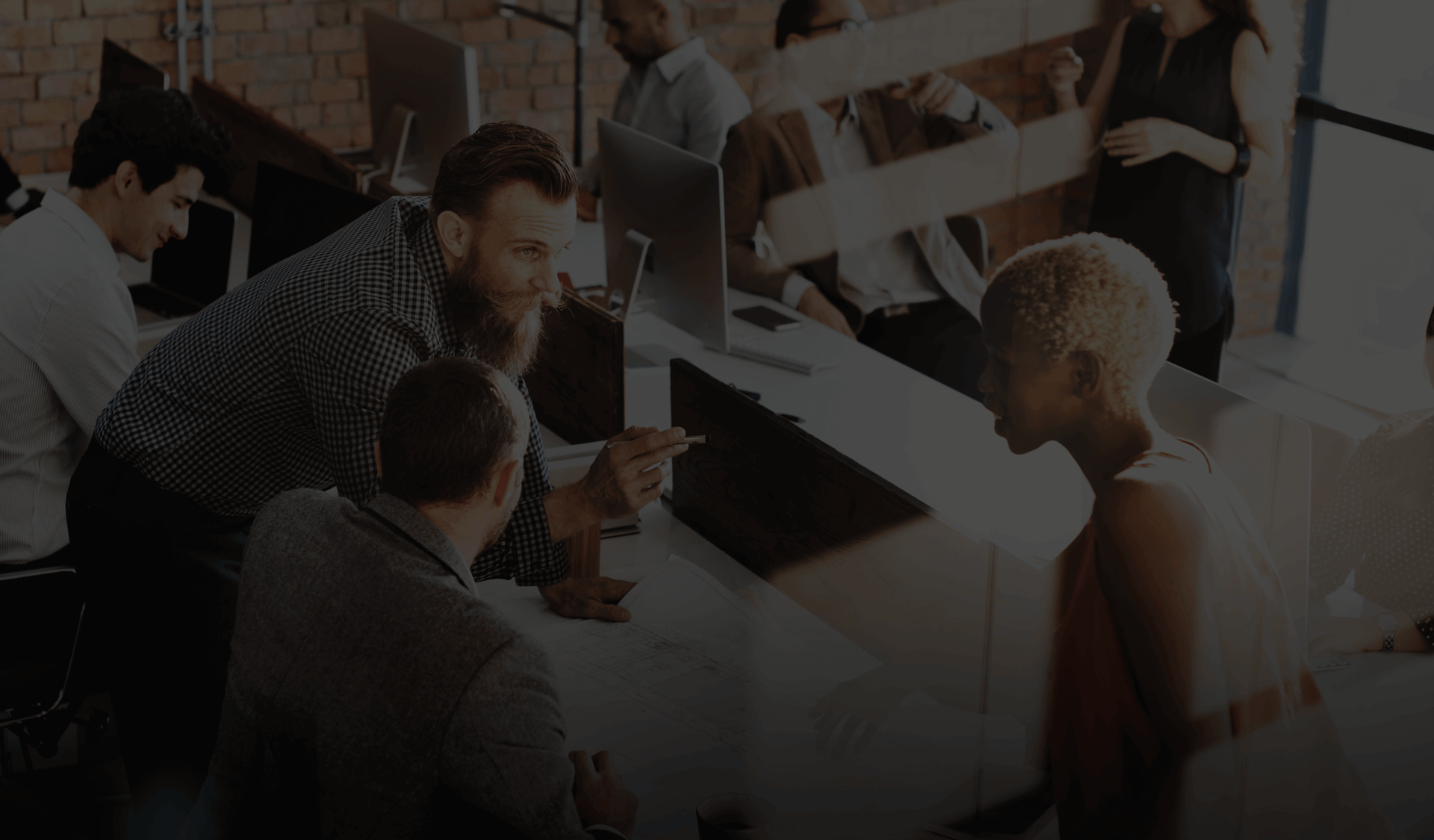
Paid Media Is a Crucial Component of Your Marketing Mix
Paid media has long been seen as primarily an outbound marketing technique, but the reality is that it can be seamlessly incorporated into an inbound strategy. A variety of paid channels can be used to complement your marketing mix and accelerate your results. But where should you start? Read on for a high-level overview of common paid channels and how you can use them in an inbound campaign.
Your paid media budget—calculated in minutes!
Our paid media budget planner and calculator will allow you to determine how much you are willing to spend, the volume of activity your ads need to create to achieve your goal for new customers, the costs associated with your conversions and clicks goals to validate your budget and the ROI you can expect if all goes according to plan.

Chapters
Paid Media and Your Marketing Mix
Accelerate Inbound Marketing
The Basics of a Paid Media Strategy
What Not to Do With Paid Media
Traditional Paid Media Channels
Opportunities with Industry Publications
Alternative Video Media Strategies
Measuring the Success of Paid Media
Paid Media and Your Marketing Mix

There are three distinct types of media that make up any digital marketing mix: earned, owned, and paid media. Using all three in combination will improve your campaigns’ ability to attract, nurture, and, ultimately, close business. For the purposes of this guide, we are focusing on paid media as a part of the digital trifecta.
What Is Paid Media, Anyway?
When thinking about how many times you’re served ads in the digital space every day, the number becomes astronomical. Imagine that you scope the current fashions from your favorite retailer, and those perfect shoes start to follow you around the internet. Or you’re about to watch yet another cat video and a sponsored video plays first, promoting a cool car zipping along the coastline. Or you’re reading your favorite cooking blog and come across a post sponsored by a chef promoting a book. Paid media is all of that and more.
As an advertiser, there are millions of paid media opportunities at your fingertips. Some are turnkey operations; others take a lot of planning. Some are inexpensive; others are pricey. Some channels are entirely dedicated to brand awareness; others are more of a nurturing tool. Whatever your time commitment, budget, or goal, paid media, when done well, is an effective arm of any marketing mix. It is instant, offers spend control, is 100 percent trackable, and, most importantly, aids in rising above the clutter on search engines, social channels, and beyond.
Throughout this guide, we’ll cover all of the most popular forms of paid media, along with some things to avoid so that you can advertise
As an advertiser, there are millions of paid media opportunities at your fingertips. Some are turnkey operations, others take a lot of planning.
Resources
Accelerate Inbound Marketing

The digital trifecta is paid media, earned media, and owned media. Inbound marketing traditionally is a coupling of the latter two, as it draws in your audience with stellar website content, blog articles, premium content, and social media engagement.
Inbound isn’t about nudging your audience along with messages promoting your brand, so it might surprise you that paid and inbound can be done in harmony.
As an advertiser, rather than trying to separate the two, use paid media as an amplifier of your great content that drives traffic to your owned media, and a way to partner with industry experts in order to create earned media. That is the digital trifecta at work in
But that isn’t a one-step plan—it requires much planning and strategy to be done well. We’ll break down the basics of a plan and the traditional media channels

Resources
The Basics of a Paid Media Strategy

A proper paid media strategy involves plenty of moving parts and decisions to make for the best-performing campaign possible. These are the aspects to keep top of mind as you put together your plan:
Budget
How much you can allocate toward paid media makes a big difference in your overall plan. Thus, the budget should be determined first so that it can dictate your paid planning. If you’re working with a smaller budget, it’s best to focus your efforts on 1-3 channels so that they’re managed well, rather than spreading yourself too thin across several channels.
Goals
Are you looking to increase brand awareness? Do you want to double your website visitation with qualified users? Perhaps you want to obtain more conversions? Or do you just want to spend your dollars nurturing the contacts you already have? Paid media vehicles have opportunities for all of these and much more. The most popular channels offer products that match your particular goal, along with tracking abilities to see what’s working and what isn’t. Similar to the budget, your goals should dictate the channels and products you choose to promote within those channels.

Creative Assets
The assets you use in your paid channels include all manner of promotion tools, including keywords, text ads, image ads, sponsored content, and rich media ads. In order for your ads to get the attention they need to send users to your stellar website or content, they need to have a couple major aspects in place:
- A simple and clean design that is pleasing to the eye and flows well with the channel you’ve selected. In the case of Facebook, choose beautiful and user-generated imagery.
- Copy that tells your story in your tone. It may be funny, serious, or loving—and it could be the user’s first touch with you.
In short, ads should be concise snapshots of your brand story and contain unique selling propositions. This can be difficult to achieve, so find your power in brevity.
Stellar Landing Page
Inbound marketing can take months and even years to regularly drive a high volume of traffic to your content, whereas paid media is immediate and often exposes your brand to users who are hearing about you for the first time. When your ads are thrown into the universe, there is a chance they will result in a visit, so making strategic decisions with your content and landing page choices is critical. When choosing your landing page, make sure these criteria are met:
- The page or content has performed well historically in submissions or conversions. It’s especially good to use content that converts well but maybe hasn’t had a lot of exposure.
- It tells your story in a real and meaningful way that shows the user how you are set apart from your competition.
- It implements bullet points and white space to communicate both clearly and concisely, with an enticing call to action (CTA) that sits above the fold.
Inbound marketing can take months and even years to regularly drive a high volume of traffic to your content.
The Agile Approach
This type of marketing can be broken down simply as responding to performance and data—and that is what paid media is all about. All channels offer extreme levels of reporting so that you can respond to performance easily and quickly. It’s important that a paid media campaign is monitored regularly with regular testing and updating for optimal performance and goal achievement. We’ll get more into measurement a little later.

Resources
What Not to Do With Paid Media

The size of your company, your target audience, geographic location, and numerous other factors all impact the effectiveness and sustainability of your marketing efforts. Although many different paid media strategies and techniques are available, there are several different methods you should avoid at all costs.
Spray and Pay
Not all marketing channels are created equal. Although it might be tempting to spend your marketing dollars on every available medium, this will often result in wasted money and poor return on investment (ROI). Instead, you should focus on a few select channels, depending on your goals, budget, and audience. Industry benchmarks and best practices can be helpful when planning which channels to use.
For example, if your target audience includes CEOs of tech companies, you might want to focus your efforts on LinkedIn and other B2B media; Facebook might be a more appropriate option for visual brands and B2C companies. Regardless of which channels you choose, remember that you must continually evaluate and optimize your campaigns in order to make sure you’re achieving the best possible results.
Buying Lists
Reserved space in newsletters or journals is a form of paid email marketing that can accelerate your inbound marketing, but it is important not to invest in some of the more nefarious methods of email marketing—namely, buying lists of contacts. Although paying a small fee for a “highly targeted” or “relevant” list of contacts may seem like a good idea, remember that this severely conflicts with the tenets of inbound marketing.

For example, imagine you’re walking down the street. A complete stranger walks up to you and starts trying to sell you something. Most people would be put off by this aggressive sales method, eliciting responses ranging from annoyance to exasperation to anger. This is essentially the same thing that happens when you buy an email list. Although someone might end up buying what you’re selling, most people will simply be annoyed that a company they’ve never heard of or talked to before has decided to spam their email address.
Besides putting off potential customers, there are some detrimental effects of a technical nature that can happen to your organization. When you purchase lists, you are more likely to be marked as spam, because the people you are emailing are not expecting to hear from you. Additionally, if you send emails to accounts that are no longer active, you will get a large percentage of hard bounces, which can affect your future email deliverability. Neither of these is a desirable outcome for email campaigns, so instead of wasting your time with purchased lists, you should convince people to
When people lie, they also seem to use more verbs than nouns, because it is easier to go on about thing you did than to describe how things were.
Artificial Reviews
Sites such as Yelp and Google are often a potential customer’s first stop when deciding whether or not to use your business for the first time. Potential job applicants might peruse Glassdoor before deciding to apply to your company. Similarly, organizations might visit sites like G2 Crowd or Software Advice before deciding to implement your software product.
Though it might be tempting to augment your reviews with artificially inflated—or purchased—reviews, this is dishonest and should be avoided. Believe it or not, distinguishing fake reviews from real ones is pretty easy. Tom Vanderbilt, in his book You May Also Like: Taste in an Age of Endless Choice, discusses this at some length. Fake reviews have a number of “tells” that make them easy to spot when compared with authentic reviews, and once the reader realizes that reviews are fake, your business will lose credibility.

“In ‘invented accounts,’ people tend to be less accurate with contextual details, because they were not actually there,” writes Vanderbilt. “Fake hotel reviews, they found, had less detailed information about things like room size and location. Prevaricating reviewers used more superlatives (The best! The worst!). Because lying takes more mental work, false reviews are usually shorter. When people lie, they also seem to use more verbs than nouns, because it is easier to go on about things you did than to describe how things were. Liars also tend to use personal pronouns less than truth tellers do, presumably to put more ‘space’ between themselves and the act of deception.”
If your organization is being plagued by bad reviews, you should address the situation with honest and open communication, even remedying the cause if at all possible. There are numerous, honest techniques for reputation management that don’t involve purchasing positive reviews.
Resources
Traditional Paid Media Channels

Pay-per-Click (PPC) Advertising
What exactly is PPC advertising? Simply put, it’s the paid version of organic search results that inbound marketers know and love. PPC is non-interruptive advertising meant to improve the user experience rather than derail it. The ads sit above the noise and clutter of organic results and offer a unique opportunity for advertisers that struggle with SEO on certain

We could write an entire Guide to PPC e-book, but for our purposes here, you should know that the most important thing to keep in mind is creating an efficient and strong experience for the user. That means you will want to have multiple campaigns, each promoting a specific service you provide. For example, one for dog walking, a second for dog grooming, a third for overnight care, and so on. Each campaign has three distinct pieces:
- Keywords that are related to the specific service you are promoting with the campaign: Tools such as the Google Keyword Tool can help you develop a nice keyword list. The best practice is to include 8-10 in each campaign.
- Ad copy specifically related to the keywords belonging to that campaign: So if you’re focusing on dog-walking keywords, only talk about dog walking in the ad. The ads should include your keywords, any offers or specials you’re running, what sets you apart from your competition, and your location, if applicable.
- A strong landing page: Perhaps the most crucial element of conversion, your landing page must clearly define a solution to the problem presented in your keyword selection.
PPC is non-interruptive ads that are meant to improve the user experience rather than derail it.
Now that you have a broad idea of what PPC is and how to create a solid campaign, here’s the question of the hour: What does PPC do to accelerate inbound marketing?
- It raises you above the clutter and noise of organic search results.
- It’s a great opportunity to promote a current special or offer with an upcoming deadline. From there, you can nurture the users with what sets you apart so that they become lifelong customers.
- The ads are useful to people and aren’t as disruptive as banner ads floating around the internet. You can show yourself as a solution to the exact problem the user is experiencing. If a user is searching “dog walker in LA,” he or she is clearly looking for that exact service, and there you are, right at the top of the search results! Once you get users to your content, you can show them why you’re the best.
- Let’s say you just wrote a piece of content and want to know how it will perform—and you want to know quickly. Rather than waiting for SEO to do its job or sending another email, you can use PPC to quickly and easily blast it to the masses.

Paid Social Channels
There are dozens of social channels that marketers can use for advertising, and most of them go one step beyond to provide multiple ad product options. They offer self-serve options that allow you to set your budget, create campaigns, and analyze—all within the platform. No matter which channel you choose, there are three important things to keep in mind when you get started with your high-level strategy: Use the targeting tools at your fingertips to match your persona’s demographics and

1. Facebook
- With more than 2.13 billion users and still growing, Facebook is an obvious choice for general brand awareness.
- When you take advantage of the targeting opportunities and promote only your best content with your best ads,
- Facebook is an incredible conversion tool. Facebook is often applauded for incredibly low cost per click, especially when you choose to just boost organic posts.
- The platform offers robust reporting so that you can test, analyze, and optimize
toward the best recipe for your audience and ad. - With the creation of an ad account, you are connected with an account manager dedicated to your account, which can be critical to success.
- Facebook offers an ad product for every marketing goal and business opportunity; you can explore these in Facebook’s Ads Guide. Below, you can see an example of a native ad paired with some ads in the right rail. All of these are focusing on website clicks as the goal. As you can see, the ad space is not disruptive at all and provides a great experience to the user.

2. Linkedin
- With more than 500 million users, LinkedIn is a mighty contender in efforts to reach a social audience due to its targeting capabilities and highly engaged users.
- The targeting options are B2B gold because you can reach an audience based on job title or the type of company where people work.
- Do you offer a product, service, or piece of content that can help people advance in their careers or teach them something new about their fields? If so, LinkedIn is absolutely perfect for you. These users are primed for this type of information.
- LinkedIn has multiple ad products to match your goals; the two most popular ones are Sponsored Content and Text Ads. Below is an example of a Sponsored Update, which appears in the native newsfeed. The only thing that sets it apart from the rest of your feed is the “Sponsored” notation and the company logo to the left.

3. Twitter
- Twitter prides itself on providing advertisers an opportunity to create campaigns based on your objective, analyze performance, and reach the right audience, so you can target the best audience possible and drive qualified traffic for conversions.
- The competition is less fierce, offering you an opportunity to truly rise above the clutter if your creatives are strong and your targeting recipe is right.
- There is much less privacy on Twitter than on other social channels, so going viral on the channel can absolutely be done, and boosting it with some marketing dollars can help.
- The targeting available is arguably the most robust of all social channels, allowing you to choose keywords, topics, companies, and other options to find your personas.
- Twitter has many types of ad products to choose from based on your goals, so be sure to use Twitter’s guide. A relatively new product, Website Cards, can be a game changer for advertisers looking to enhance website visits and conversions.
Retargeting
Do you ever feel as though one of the items on your wish list just follows you around the internet? No matter where you go, that pair of shoes or new camcorder is there. The reason is simple: retargeting.
Retargeting works using a cookies-based technology that follows your audience (historical website visitors and email addresses) around the internet. This strategy works best when paired with a larger digital strategy that is driving users to you. There are two goals that a marketer might have for including retargeting in a marketing mix:
- Awareness: Retargeting is a great way to re-engage users who may have forgotten you, especially when you’re running a great special or you have a new product offering that might entice them back.
- Conversion: A lot of people believe that when retargeting is done well, it’s the
best paid channel for nurturing users to turn them into customers.
Some of our favorite platforms are the remarketing product within the Google Display Network and AdRoll.
There are several platforms out there to choose from, and you must choose based on your goal, the kind of nurturing experience you can provide, and where your audience primarily is located on the internet. Some of our favorite platforms are the remarketing product within the Google Display Network and AdRoll, which both offer simple retargeting options that you can manage yourself in their user-friendly platforms. Speaking of

If you want to learn more about retargeting, this retargeting beginner’s guide will help you in setting up your very first campaign with success!
Google AdWords Shopping Ads
Google AdWords is a well-established paid option that displays your business’s listing on search results and
Display Ad Networks
Similar to Google, ad networks have been around since the dot-com boom in the 1990s. In all that time, countless campaigns have been launched, and improvements have been made. Marketers can buy ads across millions of publisher sites and apps and advertise to an audience that is, well, basically the size of the internet. There is an ad network for every advertiser based on your goals, budget, personas, and knowledge base. Adsterra, for example, pairs advertisers with premium publishers and targets their users across those sites.
The partner you select to work with on your display program should fit your particular needs, whether they are related to targeting, pricing, placement, or performance history. There is a network out there for everyone! Below is a good example of a targeted display ad in a travel publication for a beach destination to encourage one more beach vacation before the end of summer.

Niche/Industry Publications
We’ve talked a lot about targeting your audience using its interests, what it searches, how it interacts with its favorite social channels, and how it acts across the web. Sometimes, you can target your audience simply by choosing to work with a publication whose persona matches yours. There are thousands of publications out there with specific audiences, and they often have multiple ad products that can suit your exact needs. Head over to the publication that you know your users enjoy and scroll down to the footer where you can typically find the “advertise with us” or “media kit” button.
Account-Based Marketing
Paid media spreads your reach into channels where you hope to connect with potential customers. Account-based marketing, or ABM, takes this concept one step further by targeting specific personas with sales-focused content—as if each persona is its own unique market. For example, if you have a group of prospects with a certain pain point, you can deliver paid media ads that directly address that pain point to just those specific prospects, ideally driving them to click and move deeper into the sales funnel. HubSpot has a great blog post detailing more about ABM and how it aligns marketing and sales into a laser-focused approach to attracting and converting prospects and even existing customers.
Resources
[Infographic] Facebook Lead Ads Benchmark: How it impacted the Lead Generation business
Read MoreOpportunities with Industry Publications

Industry publications are in the business of building a highly targeted audience and charging advertisers (you) access to their audience in different ways. In order to quickly ramp up your marketing efforts, you need to include industry publications as one of your primary marketing channels.
Start by listing all the publications in your industry that you think your customers subscribe to. If you don’t know any, here are several Google searches that can help get you started:
- Best [industry] blogs
- [Industry] magazines
- [Industry] conferences
- National [industry] association
- National [industry] organization
Use your best judgment when selecting a publisher by putting yourself in the shoes of your customers. If you are unsure which publisher to use, ask your customers. Each publisher will likely have a media kit with pricing, advertising options, and a profile of its audience’s demographics. If a publisher doesn’t have information such as industry, company, job titles, and location for each contact, you should be careful about paying too much, because you need to ensure that its audience is active and qualified.

If you don’t yet have a personal connection but have found an ideal publisher, reach out to the appropriate contacts and begin establishing a relationship. You can find the advertising contact’s information on the publication’s website by navigating to the “contact” or “advertising” section, which is often linked in the footer of the home page. Both types of pages should have a primary contact for advertising inquiries. The publisher should also have its media kit available for download on the advertising page.
Just as you have nurtured your relationship with the editors at the publications, you also need to work the relationship with the salespeople who call, you asking you to advertise in their magazines. Though we don’t always suggest traditional paid ad placement in print publications, there are alternative paid media options that can help you drive traffic and leads to your website. Let’s take a look at the types of paid media agreements you can make with publishers that will support your inbound marketing efforts:
Cost-per-Lead (CPL) Campaigns
If you have a limited email list and are looking to quickly expand your audience and drive more leads into your sales funnel, contact the publisher’s sales team and start a discussion about running a CPL campaign. A CPL campaign is when the advertiser pays the publisher any time a user takes an action on the publisher’s website that generates a lead for the advertiser. It is one of several types of pricing models you can choose from in the paid advertising space.
CPL works by either hosting your content on the publisher's website and placing it behind a form (gated content) or having the publisher drive traffic to your landing page and tracking how many leads are generated. Any time someone downloads the content, you will receive the new lead, and you pay the publisher an agreed-upon price.

You have surely run across these types of campaigns when browsing the internet. If the publisher is following the rules of the Federal Trade Commission, you will see the word “sponsored” next to any editorial content offers, such as an e-book or podcast, or display ads.
Steps for a Successful CPL Campaign
- Take your most popular or currently relevant content offer (e.g., e-book) and determine the target audience for the content.
- Choose the publisher that speaks to that audience and discuss setting up a CPL campaign that targets your ideal customer.
- Choose custom targeting that can be done in several ways, such as geographic, organizational, industry vertical, and job title. It all depends on what demographic and organizational data the publisher has been collecting. Pro tip: Ask the publisher to exclude your competitors based on company name or email address.
- Agree on what you will pay the publisher per lead. The cost will depend on the quality of the publisher’s database. For a reference, here is a list of the average cost per lead for different industries:
- Send over any marketing materials (e.g., e-book file, landing page copy, thank you email copy, banner ads, and the types of information you want collected on the landing page form) the publisher needs in order to be successful. Ask if you can A/B-test copy, images, ads, and so on. Many publishers have the capability to A/B-test and allow you to optimize after a week or two of results.
- Ask to review and test the campaign before it goes live.
- Once the campaign is published, share on your social profiles and with your email list in order to help with promotion. Aligning your brand with a reputable publisher will boost your brand awareness and reputation, thus continuing to establish your organization’s people as thought leaders in the industry.
- Measure the campaign performance. Were the leads qualified? Did the campaign generate enough leads? Was the CPL within your budget and goals? How can you optimize for improved success with your next campaign?
- If your campaign was a success, consider duplicating it with other publishers or allocating more budget with your initial publisher until you start seeing performance drop.
CPL works by either hosting your content on the publisher's website and placing it behind a form (gated content) or having the publisher drive traffic to your landing page.
Sponsored Email Campaigns
Similar to how you can pay a publisher to host and promote your content with a CPL campaign, you can also pay for your content to be included within a publisher’s email newsletters, or you can completely sponsor its newsletter and send a custom email promoting your content.
The steps for a successful sponsored email campaign are similar to those for a CPL campaign. The main difference is that traffic is being directed to your website and not a landing page on the publisher's site.
Strategies for a Successful Sponsored Email Campaign
- Choose the right content to promote based on how well it has performed on your website and resonated with your audience.
- If your goal is to generate many leads, choose awareness-stage content to promote within the sponsored email.
- Focus the email on one goal (e.g., downloading an e-book) rather than including multiple CTAs in one email.
- Choose publishers that have strong email subscriber lists with strong demographic data.
- Ensure that publishers can show you that their audience matches your target audience, or that the publisher allows for custom targeting.
- Ask if you can remove competitors from the email list.
- Request average campaign results for similar companies or content offers that the publisher has done in the past (cost per mille, email open rate, click-through rate, and leads).
- Ask if you can perform an A/B test on the subject line and email content (if not, perform your own internal A/B test and use the winning option for the campaign).
- Create and thoroughly test a custom conversion path for the campaign (email HTML, CTA, landing page, thank you page, follow-up email, and lead nurturing).
Every industry has several publishers with email newsletters, and some of them already have sponsored email campaign options as part of their paid media kit. If not, simply ask if they would be willing to arrange a sponsored email send. Outside of the industry, you can look to related email newsletters that your target audience is subscribed to. For example, SmartBrief has a long list of email newsletters in different verticals, and its media kit includes multiple custom sponsored email send options. Each industry has its own niche publications that have highly targeted contact databases.

Sponsored Webinars
Sponsored webinars are a powerful way to get a larger audience to engage with your content in a unique way, plus the recorded version can act as a lead-generation content offer afterward. To learn more about webinars, read The Marketer’s Guidebook to Hosting a Webinar. If you have a limited audience of your own or are looking to grow leads, you will need to work with and pay a publisher that has a webinar program.
Again, start with finding out what the industry publishers have to offer. If they don’t have anything, propose the sponsored webinar idea at a much lower cost, because they don’t already have a webinar program. Then, choose your topic wisely. For example, if your business is mechanical, pick an engineering topic for an engineering-focused publisher. If the publisher is a magazine that targets C-suite executives, an engineering webinar topic won’t resonate with it. However, a webinar discussing how to improve profitability will. Remember: This is not an advertisement—this is an opportunity to have the thought leaders on your team share some knowledge in a live webinar. If people notice it is “
Sponsored webinars are a powerful way to get a larger audience to engage with your content in a unique way.
Here is an example of a landing page on Windpower Engineering & Development’s site that was used to promote an upcoming webinar sponsored by 3M. After the webinar, the landing page was used as a lead-generation form for anyone who wanted to watch the recorded webinar.

Tips for a Successful Sponsored Webinar Campaign
- Ensure that the topic, presentation, and speaker are chosen or at least managed by your team. You want to control the conversation if you are paying for it.
- Webinars should only be used for educational topics, not self-promotion. You can talk about your products/services if they are truly innovative and have scientific analysis that can be presented in order to inform viewers, but do not sell try to sell viewers any particular products/services.
- Ask one of your technology partners to give the presentation with you. Tell your partner that you are covering the costs of the webinar and would like its support with half of the PowerPoint deck and giving the live presentation. This is an important step that can give your webinar more credibility and attract a wider audience.
- Cross-promote with your technology partner, inviting both of your contact databases to the webinar. Track what leads come from each of your efforts. Learn more about co-marketing here.
- Because you are paying the publisher for leads, you should know exactly what marketing it is doing in order to drive registrations. Give the publisher all the marketing materials necessary to successfully promote the webinar to its audience.
- Choose publishers that have successfully run webinars in the past and can guarantee a minimum number of people registered.
- Practice your presentation multiple times, but don’t write your talk down verbatim. Simply use bullet points and practice a few times.
- Do 15 jumping jacks just before the presentation to get your blood pumping and excitement up. Your audience can hear your enthusiasm in your voice.
- Confirm that you will receive both the registration and attendee list with all the data collected from each contact so that you can follow up with them after the webinar. This should include who asked what questions during the Q&A.
- Quickly publish the recorded version of the webinar, share it with the registrants, and provide them with a new piece of content related to the topic—product reviews, FAQs, an ROI calculator—that helps move them through the Buyer’s Journey. If your webinar was product-focused, ask them to schedule a demo or consultation.
Alternative Video Media Strategies

They say a picture is worth a thousand words—but what about a video? Including various different forms of video content into your inbound strategy is a surefire way to get people interested in your content, and research has shown that videos positively increase conversion rates across the board.
Boost Facebook Live Videos
In a world of ever-changing algorithms, keeping your posts at the top of Facebook’s newsfeed can be a near impossible task. Boosting your Facebook videos is the most efficient way to ensure that your content is seen. Data has also shown that people comment over 10 times more on Facebook Live videos than on regular videos, thus making it one of the best ways to drive engagement across your social media channels. You can use a livestream to:
- Promote new content.
- Do a Q&A session.
- Showcase a new product.
- Give a sneak peek of events in real time.
YouTube Ads
You may be familiar with YouTube as a video hosting platform, but it also has a powerful advertising feature in the form of video ads:
- 75 percent of online video viewers have interacted with an online video ad this month.
- YouTube ads promote better conversion rates than other video platforms.
- YouTube’s video ad platform is delivered with AdWords—making it familiar territory for many marketers.
Product Placement
When you hear the term “product placement,” you might think of huge films such as the James Bond or Transformers movies, but it doesn’t always have to be that costly or complicated. With the explosion of vlogging and YouTube, product placement is becoming a more and more attainable method of promoting your company’s products. Considering that top YouTubers have millions of followers, getting just one to review or mention your product can have a huge impact on your social reach.
With the explosion of vlogging and YouTube, product placement is becoming a more and more attainable method of promoting your company's products.
Wistia Turnstile
Wistia’s Turnstile feature is a lead-generation form that is directly embedded into your video content. You can require this form to be filled out or have it pop up at certain times during your video:
- You can use Wistia’s Turnstile in order to capture leads from videos shared directly to social media.
- Research from Wistia has shown that the average conversion rate for a required Turnstile is 26 percent.
Combine this feature with paid social and you have the potential to see a significant boost in your lead-generation efforts.

Measuring the Success of Paid Media

Tracking the success of your paid media campaigns can be a tricky task. Although some campaigns are directly measurable by the amount of conversions or leads generated, goals such as brand awareness and driving traffic can be more difficult to quantify.
That said, there are three primary goals in paid media:
- Increasing traffic and brand awareness
- Lead generation
- Nurturing
leads
In order to measure the success of your campaigns, you have to measure metrics directly related to each of these three goals.
Traffic and Brand Awareness
Although quantifying your ROI for brand awareness campaigns can be difficult, they're still important for getting visitors to your website and increasing your reputation. In order to measure the effectiveness of these campaigns, there are a couple different metrics you should pay attention to, depending on which channel or medium you use:
- For a guest-blogging campaign designed to drive traffic to your website, you would measure referral traffic and website visits related to those blog posts.
- If you were boosting a Facebook Live video, you would measure viewers and social engagement instead.
This example shows a Ford ad on Twitter trying to promote awareness of the Ford Fusion Sport. No doubt the marketers behind it are keeping an eye on the clicks and website visits, as well as the favorites, retweets, and replies that they get.

Lead Generation
Driving leads to your website is probably the most common goal when it comes to paid media. After all, how can you expect your sales team to close deals if it doesn’t have any potential customers in the funnel? For these types of campaigns, you want to measure the number of people who fill out a form, claim an offer, or sign up for a promotion:
- If you’re running a sponsored webinar, then you want to measure the number of attendees.
- If you’re promoting a landing page through LinkedIn’s sponsored updates, you would look at form submissions.
- If you’re running a promotional offer through ads on Facebook, you would similarly measure the number of leads.

That said, the success of your lead-generation campaigns are not just measured by
Driving leads to your website is probably the most common goal when it comes to paid media.
Nurturing Leads
Nurturing campaigns aren’t as straightforward as lead generation; however, they are just as important to your sales funnel. After all, most first-time visitors to your website won’t be ready to make a purchase quite yet, so it’s important to nurture these contacts until they are ready. Some methods of nurturing can be easily measured, but others not so much. An easier metric to gauge is the number of leads who converted on a retargeting ad and made a purchase. You can also use filters on LinkedIn’s paid updates to specifically target people or companies that you’ve been in contact with.

Other methods of nurturing aren’t as straightforward. Vigilant data collection and analysis are needed in order to track the number of leads and marketing qualified leads that interact with your paid media and progress further down the sales funnel.
Resources
Steal This Workflow: eCommerce Businesses Leverage Facebook Lead Ads to Connect with Customers
Read More Download this guide, PLUS Outcome Model Worksheet
Download this guide, PLUS Outcome Model Worksheet
Simply fill out this form to receive a PDF version of our guide. We’ll also include our paid media outcome worksheet as a bonus.



